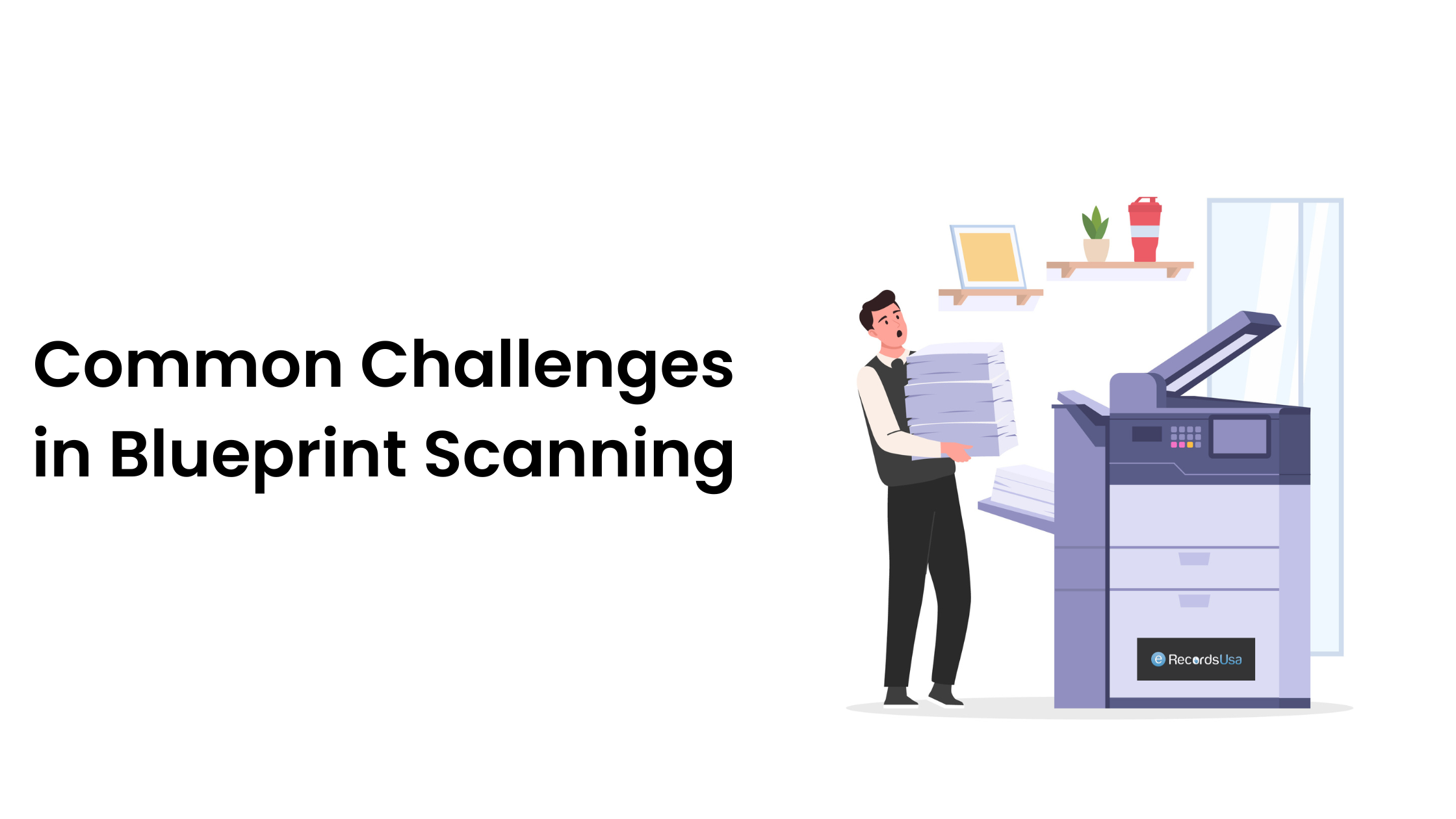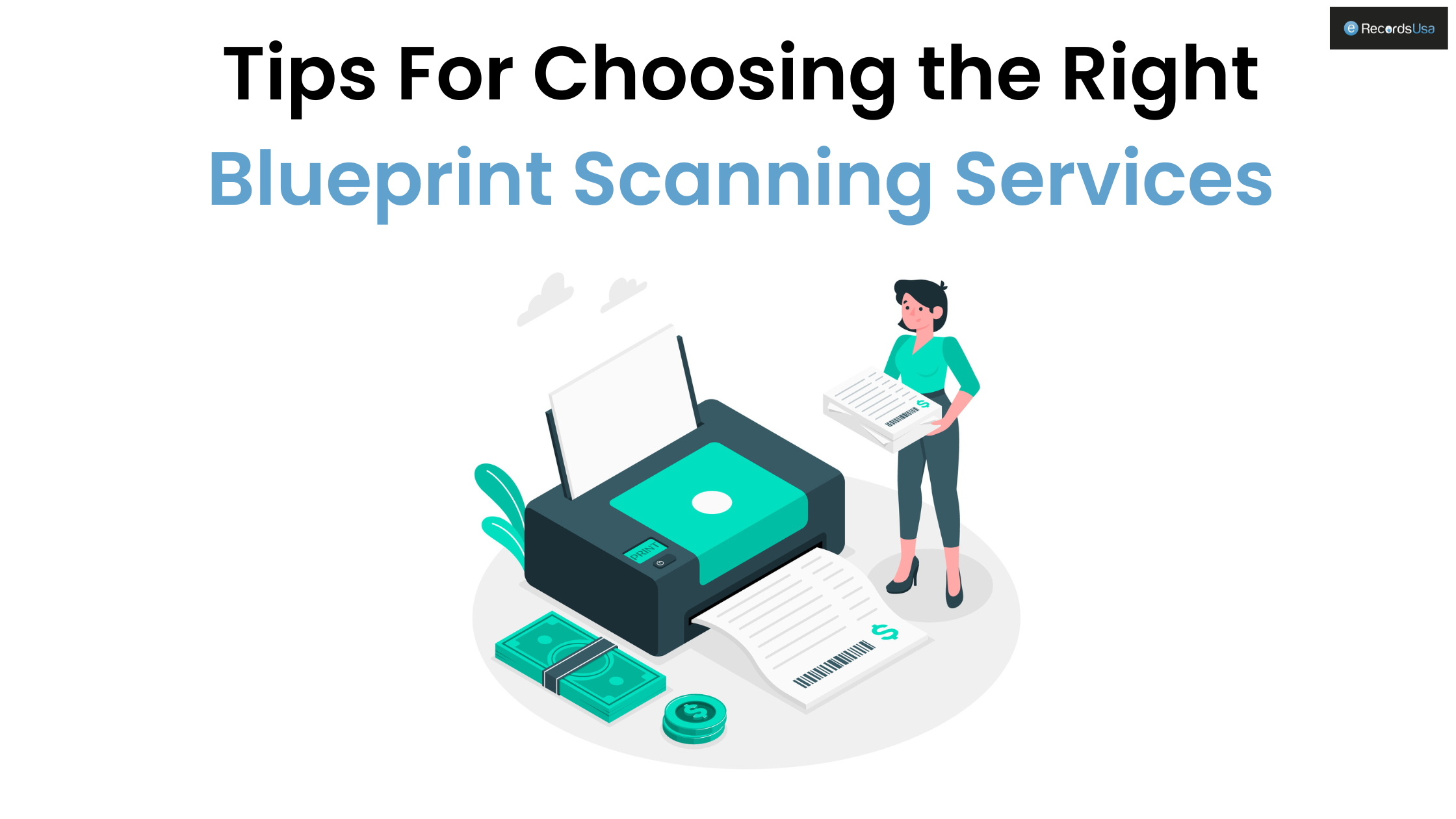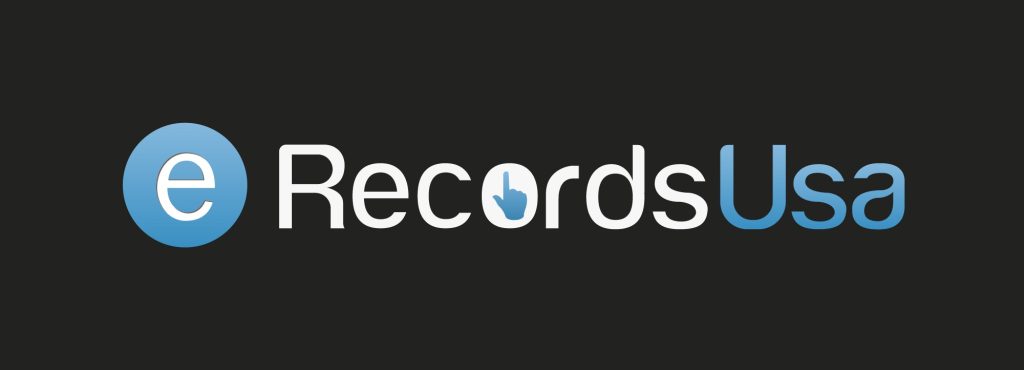Choosing the right equipment and settings for scanning is crucial for professionals in fields like architecture, engineering, and construction. Precision and clarity in digital copies of blueprints are paramount in ensuring accurate representation and effective communication of designs and plans.
But, while choosing a scanner, especially for detailed documents like blueprints, several key features should be considered including resolution, size compatibility, color fidelity, have high-quality scanners designed specifically for large-format documents like blueprints. These scanners typically feature advanced optics, precise calibration, and the ability to capture fine details with high accuracy.
In addition, service providers use industry-standard settings that prioritize high resolution and color accuracy. This often includes scanning at a minimum resolution of 300-600 DPI (dots per inch) to ensure crisp and legible text, lines, and details.
Always remember that the ideal scan resolution for blueprints is 300-400 DPI (Dots per inch). It is generally considered suitable for most blueprint applications as it provides a balance between file size and image quality. However, for larger prints or intricate details, a higher resolution of 600 DPI or more may be recommended to capture every nuance accurately.
So, while looking for a blueprint scanning services, keep in mind all the factors. We are going to discuss more details about this in further blog. Let’s get started!
What is Blueprint Scanning?
Blueprint scanning converts physical blueprints into digital files. These digital files are often saved as PDFs or CAD drawings. This involves using specialized scanners to capture a high-resolution image of the blueprint. These scanners can handle oversized documents. Blueprints are often larger than standard paper sizes.
The process turns paper blueprints (architectural, engineering diagrams/drawings, large non-standard book pages, newspaper sheets, maps, and schematics) into electronic copies. These digital copies are high-quality image files. They capture every detail from the original blueprints. Learn more about the different types of blueprint scanners.
Benefits of Blueprint Scanning
Digitizing your blueprints through professional scanning services offers numerous advantages that can streamline your operations and enhance collaboration. Converting physical blueprints into high-quality digital files brings benefits that span efficiency, accessibility, and cost savings.
-
Improve Collaboration
Digital blueprints facilitate seamless sharing of information among project stakeholders, including architects, engineers, contractors, and clients. With the ability to instantly distribute and access the files electronically, teams can collaborate more effectively, reducing delays and miscommunications.
-
Enhance Data Security
Physical blueprints are susceptible to damage, loss, or theft, which can compromise sensitive information. On the other hand, digital files can be securely stored and backed up, ensuring that your valuable data remains protected and easily retrievable.
-
Space Saving
Storing physical blueprints can consume significant office or storage space, leading to clutter and organizational challenges. Digitizing your documents can free up valuable space while maintaining easy access to your files through digital storage solutions.
-
Better Document Management
Searching for and retrieving specific blueprints from a physical archive can be time-consuming and prone to errors. With digital files, you can leverage powerful search and indexing capabilities, allowing you to quickly locate and access the information you need.
-
Integration with Software Tools
Digitized blueprints can be seamlessly integrated with various software applications used in the construction industry, such as Building Information Modeling (BIM) tools, project management platforms, and Computer-Aided Design (CAD) software. This integration streamlines workflows and enhances productivity.
-
Environmental Sustainability
By reducing the reliance on paper-based documentation, blueprint scanning services contribute to environmental sustainability efforts. Digital files eliminate the need for printing, storing, and transporting physical copies, minimizing your carbon footprint.
-
Cost Savings
In the long run, digitizing your blueprints can lead to significant cost savings. You can reduce expenses associated with physical storage, printing, distribution, and maintenance of paper-based documents, freeing up resources for other priorities.
Common Challenges in Blueprint Scanning and How to Overcome Them
While blueprint scanning offers numerous advantages, the process can present some challenges that need to be addressed. Understanding these common hurdles and implementing effective strategies can ensure a smooth and successful digitization project.
-
Oversized Documents
Blueprints and architectural drawings are often larger than standard paper sizes, making them difficult to scan with regular desktop scanners. To overcome this challenge, it’s essential to work with a blueprint scanning service that utilizes specialized large-format scanners capable of handling oversized documents.
-
Maintain Image Quality
Blueprints often contain intricate details, precise lines, and specific color codes that are crucial for accurate interpretation. High-quality scanning equipment and optimized settings are necessary to capture these elements faithfully. Reputable scanning providers invest in advanced scanners that can reproduce images with high resolution and color accuracy.
-
Handle Delicate or Aged Documents
Some blueprints may be delicate or aged, making them susceptible to damage during the scanning process. Handling such blueprints requires specialized techniques, similar to those used in digitizing historical documents. Professional scanning services employ specialized methods and equipment designed to handle fragile documents gently, ensuring their preservation while capturing high-quality digital copies.
-
Ensure Data Security
Blueprints often contain sensitive information, such as proprietary designs, confidential client data, or trade secrets. It’s crucial to work with a scanning service that implements robust security measures to protect your data during the scanning process, transmission, and storage. Look for providers that offer encryption, access controls, and secure data storage facilities.
-
Manage Large Volumes of Documents
Construction projects can generate vast quantities of blueprints, making it challenging to scan and organize them efficiently. Experienced scanning services have streamlined workflows and batch scanning capabilities to handle large volumes of documents quickly and accurately.
-
Integration with Existing Systems
Digitized blueprints need to be compatible with your existing software and systems, such as Building Information Modeling (BIM) tools, project management platforms, and Computer-Aided Design (CAD) software. Choose a scanning provider that adheres to industry standards and can deliver files in the required formats for seamless integration.
Hence, partnering with a reputable blueprint scanning service that understands these challenges and has the expertise and resources to address them, you can ensure a successful digitization project. Overcoming these hurdles will open the full benefits of blueprint scanning.
Tips For Choosing the Right Blueprint Scanning Services
Choosing the right blueprint scanning service requires careful consideration of several factors to ensure a successful project. Here’s a helpful guide:
1. Assessing Your Requirements
Before exploring different providers, take a thorough assessment of your project’s requirements. Consider the following aspects:
- Volume: Determine the approximate number of blueprints or oversized documents you need to digitize. This will help potential service providers to accurately understand your project scope and workload to provide accurate quotes.
- Type and Size: Specify the types of documents involved, such as architectural drawings, engineering plans, construction blueprints, or a combination thereof. Also, note the typical sizes of these documents, as some may require specialized large-format scanning equipment.
- Desired Turnaround Time: Communicate clearly about your timeline expectations for the scanning project. Do you require the digital files urgently for an ongoing project, or is there more flexibility? If you have tight timelines, prioritize services that can accommodate your schedule without compromising quality.
- Budgetary Constraints: Blueprint scanning services come with varying costs. Be upfront about your budget to ensure the chosen service aligns with your financial limitations. It’s essential to find a provider that offers competitive pricing within your allocated resources.
2. Quality of Scanning Equipment
Ask about the scanning equipment that the potential providers. High-resolution scanning technology scanners are essential for producing accurate and detailed digital files that faithfully represent the original blueprints. This guarantees the digital files are crisp, clear, and accurate representations of the originals.
Look for services that use the latest large-format scanners capable of handling oversized documents while preserving color accuracy, line clarity, and intricate details. Advanced scanners often feature features such as high optical resolution, advanced image processing, and the ability to handle delicate or aged documents without causing further deterioration.
3. Security Measures
Your blueprints may contain sensitive information, such as proprietary designs, confidential client data, or trade secrets. As such, data security should be a top priority when choosing a scanning service.
Reputable providers should employ robust security protocols throughout the entire scanning process and after delivery. These measures may include:
- Encryption of digital files during transmission and storage
- Access controls and user authentication for restricted access
- Secure data storage facilities with physical and digital safeguards
- Strict non-disclosure agreements and confidentiality policies for employees
It is essential to ask potential providers about their specific security measures and to make sure they are in line with your organization’s data protection policies.
4. Experience and Reputation
Don’t forget to consider the service provider’s experience in the industry and their reputation among clients. So, look for companies with a proven track record of successfully digitizing blueprints for architects, engineers, and construction firms.
It’s also recommended to research the provider’s portfolio and case studies to evaluate the quality of their work and the types of projects they have handled.
Pay attention to testimonials and reviews from previous clients, as they can provide valuable insights into the provider’s reliability, customer service, and overall satisfaction levels.
5. Compliance with Industry Standards
Ensure that the scanning service adheres to relevant industry standards and best practices. This includes compliance with building information modeling (BIM) standards, if applicable, and the ability to produce files compatible with popular design and construction software.
As long as the blueprints conform to industry standards, the digitized plans can be seamlessly integrated with your existing workflows and software applications, enabling collaboration along with interoperability across different platforms.
6. Cost Transparency
Evaluate the pricing structure and look for transparency in costs. For a better understanding of costs, check out our guide on the average cost of document scanning. Reputable providers should offer clear and upfront pricing, without hidden fees or unexpected charges. Request detailed quotes that itemize the costs for various services, such as scanning, indexing, file formatting, and delivery.
Cost should not be the sole determining factor, but you should look for a provider that offers competitive pricing within your budget. However, be cautious of extremely low prices, as they may indicate compromises in quality or service levels.
Consider the overall value proposition, balancing cost with the quality of services, turnaround time, and the provider’s reputation and experience.
7. Turnaround Time
Ask about the typical turnaround time for scanning projects. If you have tight deadlines or urgent requirements, prioritize services that can meet your timeframes without compromising quality.
Several providers may offer expedited services for an additional fee, which can be beneficial if you need to digitize blueprints quickly for a time-sensitive project or bid submission.
Additionally, make sure you know the provider’s capacity to handle large or complex projects simultaneously, as well as their ability to scale resources as needed to meet your deadlines.
8. Customer Support
Reliable customer support can make a significant difference, especially if you encounter any issues or have specific requirements throughout the scanning process.
Look for providers that offer responsive and knowledgeable support, either through dedicated account managers or easily accessible customer service channels such as phone, email, or online portals.
Evaluate the provider’s communication protocols and responsiveness during the initial inquiry and sales process, as this can be an indicator of their overall customer service approach.
Convert your Maps, Plans & Blueprints into Digital Copies with eRecordsUSA!
Having a reliable partner for blueprint scanning services is paramount. eRecordsUSA emerges as the trusted choice, offering a comprehensive suite of solutions tailored to meet the unique demands of the region’s professionals.
With a deep understanding of the intricacies involved in digitizing architectural drawings, engineering diagrams, large book pages, newspaper sheets, maps, and schematics, eRecordsUSA has established itself as the go-to provider for blueprint scanning services in San Francisco, Bay Area, CA.
Our state-of-the-art scanning technology, combined with a team of experienced professionals, ensures that every detail of your blueprints is captured with exceptional accuracy and precision. You can count on eRecordsUSA for high-resolution images of intricate designs or accurate color renditions of complex engineering plans.
Our adherence to industry standards and best practices ensures that your digitized blueprints seamlessly integrate with popular design and construction software, streamlining collaboration and optimizing workflows.
With a commitment to fast turnaround times and exceptional customer service, eRecordsUSA understands the time-sensitive nature of projects in the Bay Area. Our dedicated team is ready to support you every step of the way, providing prompt assistance and ensuring a seamless experience from start to finish.
So, choose eRecordsUSA for your blueprint scanning services in the San Francisco Bay Area, CA as your trusted partner who combines technical expertise, industry knowledge, and a dedication to customer satisfaction.
Contact us today to scan your maps, plans & blueprints into digital copies with eRecordsUSA!
FAQs:
How do you scan blueprints?
Scanning blueprints involves preparing the documents, calibrating a large-format scanner, configuring settings like resolution and file format, carefully positioning the blueprint, scanning with techniques like book-edge or auto-stitch for oversized documents, reviewing previews, capturing the scans, and conducting quality checks.
What are the factors that determine a scanner’s quality?
Key factors influencing scanner quality include optical resolution, color bit depth, scanning speeds, maximum document size, advanced features like auto-stitch and de-skew, build quality and duty cycle, software capabilities, and compatibility with various operating systems and file formats. High-quality scanners excel in resolution, color accuracy, robust paper handling, and overall scanning fidelity.
How long does it take to scan 1000 pages?
Scan time for 1000 pages depends on the scanner’s rated speed (e.g. 200 ppm at 300 dpi), document sizes, simplex vs duplex scanning, need for manual intervention, and post-scan processing steps. A fast scanner could capture 1000 letter pages in 5-10 minutes, but 1000 large blueprints may take 1-2 hours including setup, handling, and quality assurance.



